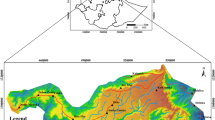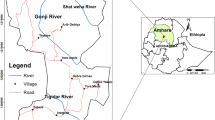Abstract
The Mila town (east Algeria) has suffered frequent landslides during the last few decades because of its geological, geomorphological, and seismotectonic setting, as well as the anthropic activities. This research work deals with the landslide susceptibility assessment using frequency ratio (FR) and information value (IV) methods in GIS technology in this area. Firstly, a landslide inventory map was constructed from interpretation of high-resolution satellite images, field investigations, and bibliographies. Seven various causal factors are lithology, slope, aspect, altitude, land use, INDV, and density of streams. A thematic layer map is generated for every factor using geographic information system (GIS), the lithological units extracted from the geological database of the Mila region. The slope gradient, aspect, and density from streams were calculated from the digital elevation model (DEM). Contemporary land use map and INDV was derived from satellite images and field study. The analysis of the relationship between landslide factors and landslide events was performed in a GIS environment. Consequently, landslide susceptibility maps (LSMs) were produced through the process of classifying the global landslide sensitivity index (LSS) into five classes. Finally, for model verification, the LSMs obtained with the FR and IV models were confirmed comparing LSMs with the landslide inventory map using both the receiver operating characteristics (ROC) and the seed cell area index (SCAI) models. The area under curve (AUC) results demonstrate that the IV method has more performance (85.9%) for landslide susceptibility maps (LSMs) than FR method (83%). Moreover, the results of the validation using SCAI also confirmed that model IV was more precise than the FR model. The models employed in this study are capable to resolve the issue of the landslide susceptibility of the study area. The obtained susceptibility maps can be used for future land use planning and can be considered as a powerful tool to resolve the spatial distribution of the risk associated to landslides.










Similar content being viewed by others
References
Achour Y, Boumezbeur A, Hadji R, Chouabbi A, Cavaleiro V, Bendaoud EA (2017) Landslide susceptibility mapping using analytic hierarchy process and information value methods along a highway road section in Constantine, Algeria. Arab J Geosci 10(8):194
Achour Y, Garçia S, Cavaleiro V (2018) GIS-based spatial prediction of debris flows using logistic regression and frequency ratio models for Zêzere River basin and its surrounding area, Northwest Covilhà, Portugal. Arab J Geosci. https://doi.org/10.1007/s12517-018-3920-9
ANRH (1993) Rainfall map of northern Algeria at 1: 500,000. Explanatory note - National agency for hydraulic resources, Algiers, 49 p
Ayalew L, Yamagishi H (2005) The application of GIS-based logistic regression for landslide susceptibility mapping in the Kakuda-Yahiko Mountains, Central Japan. Geomorphology 65(1):15–31
Bai S, Wang J, Lu G, Zhou P, Hou S, Xu S (2010) GIS-based logisticregression for landslide susceptibility mapping of the Zhongxiansegment in the Three Gorges area, China. Geomorphology 115:23–31. https://doi.org/10.1016/j.geomorph.2009.09.025
Benzaid R, Tekkouk M (2017) Study of stability of the slope of access to the viaduct of Wadi Dib, Northeast Algeria. Am J Civil Environ Eng 2(3):21–29
Bo NW, Fabius M, Fabius K (2008) Impact of global warming on stability of natural slopes. Proseedings of the 4th Canadian conference on geohazards: from causes to management. Presse de l’Université Laval, Québec, p 594
Bougdal R, Belhai D, Antoine P (2006) Geology of the city of Constantine and its surroundings. Bull Serv Geol Algeria 18:3–23
Bounemeur N, Benzaid R, Atoub S (2019) Landslides in the Mila basin-AGIS approach. In: Kallel A. et al. (eds) Recent advances in geo-environmental engineering, geomechanics and geotechnics, and geohazards. CAJG 2018. Advances in science, technology & innovation (IEREK interdisciplinary series for sustainable development). Springer, Cham. https://doi.org/10.1007/978-3-030-01665-4_100
Bourenane H, Meziani A, Ait Benamar D (2021) Application of GIS-based statistical modeling for landslide susceptibility mapping in the city of Azazga, Northern Algeria. Bull Eng Geol Env 80:7333–7359. https://doi.org/10.1007/s10064-021-02386-0
Bourenane H, Bouhadad Y, Guettouche MS, Braham M (2015) GIS-based landslide susceptibility zonation using bivariate statistical and expert approaches in the city of Constantine (Northeast Algeria). Bull Eng Geol Environ 74:337–355
Bourenane H, Guettouche MS, Bouhadad Y, Braham M (2016) Landslide hazard mapping in the Constantine city, Northeast Algeria using frequency ratio, weighting factor, logistic regression, weights of evidence, and analytical hierarchy process methods. Arab J Geosci 9:1–24
Chung CJ, Fabbri AG (2003) Validation of spatial prediction models for landslide hazard mapping. Nat Hazards 30:451–472. https://doi.org/10.1023/B:NHAZ.0000007172.62651.2b
Coiffait PE, Vila JM, Guellal S (1977) Geological map d’El Aria at 1/50000
Coiffait Ph-E (1992) Un bassin post-nappes dans son cadre structural: l’exemple du bassin de Constantine (Algerie Nord-Orientale). Thèse DoctoratEs-Sciences, H. Poincaré University, Nancy I, France, 502 p. In French
Corominas J, Van Westen C, Frattini P, Cascini L, Malet JP, Fotopoulou S, Catani F, Van DenEeckhaut M, Mavrouli O, Agliardi F, Pitilakis K, Winter MG, Pastor M, Ferlisi S, Tofani V, Herva’s J, Smith JT (2014) Recommendations for the quantitative analysis of landslide risk. Bull Eng Geol Env 73:209–263
CRAAG (n.d.) Astronomical, Astrophysical and Geophysical Research Center-Algeria
Cruden DM, Varnes DJ (1996) Landslide types and processes, special report. Transport Res Board, Natl Acad Sci 247:36–75
Dai FC, Lee CF (2001) Terrain-based mapping of landslide susceptibility using a geographical information system: a case study. Can Geotech J 38(5):911–923
Dai FC, Lee CF (2002) Landslide characteristics and slope instability modeling using GIS, Lantau Island, Hong Kong. Geomorphology 42(3):213–228
Dieu TB, Owe L, Inge R, Oystein D (2011) Landslide susceptibility analysis in the Hoa Binh province of Vietnam using statistical index and logistic regression. Nat Hazards 59:1413–1444. https://doi.org/10.1007/s11069-011-9844-2
Djerbal L, Alimrina N, Melbouci B, Bahar R (2014) Mapping and management of landslide risk in the city of Azazga (Algeria). Landslide science for a safer geoenvironment. pp 463–468
Djerbal L, Khoudi I, Alimrina N, Melbouci B, Bahar R (2017) Assessment and mapping of earthquake-induced landslides in Tigzirt City, Algeria. Nat Hazards 87(3):1859–1879. https://doi.org/10.1007/s11069-017-2831-5
Fell R, Corominas J, Bonnard C, Cascini L, Leroi E, Savage WZ (2008) Guidelines for landslide susceptibility, hazard and risk zoning for land use planning. Eng Geol 102:85–98
Ficheur M (1899) Geological map at 1/50 000 of Constantine
Gomes A, Gaspar J, Goulart C, Queiroz G (2005) Evaluation of landslide susceptibility of Sete Cidades Volcano (S. Miguel Island, Azores). Nat Hazards Earth Syst Sci 5:251–257
Gostelow P (1991) Rainfall and landslides. In: Almeida-Teixeira M, Fantechi R, Oliveira R, Gomes Coelho A (eds) Prevention and control of landslides and other mass movements. CEC, Bruxels, pp 139–161
Hadji R, Rais K, Gadri L, Chouabi A, Hamed Y (2017) Slope failure characteristics and slope movement susceptibility assessment using GIS in a medium scale: a case study from Ouled Driss and Machroha municipalities, Northeast Algeria. Arab J Sci Eng 42:281–300. https://doi.org/10.1007/s13369-016-2046-1
Keefer DK (1984) Landslides caused by earthquakes. Bull Seismol Soc Am 95:406–421
Kherrouba H, Lamara M, Benzaid R (2019) Contribution of electrical tomography to the study of landslides in Texenna region (Northeast Algeria). In: Sundararajan N et al (eds) On significant applications of geophysical methods, Advances in science, technology & innovation. https://doi.org/10.1007/978-3-030-01656-2_11
Lee S, Talib JA (2005) Probabilistic landslide susceptibility and factor effect analysis. Environ Geol 47:982–990
Magliulo P, Di Lisio A, Russo F, Zelano A (2008) Geomorphology and landslide susceptibility assessment using GIS and bivariate statistics: a case study in southern Italy. Nat Hazards 47:411–435. https://doi.org/10.1007/s11069-008-9230-x
Merghadia A, Yunusb AP, Douc Jd, Whiteleye J, ThaiPhamg B, TienBuihn B, Avtari R, Boumezbeur A (2020) Machine learning methods for landslide susceptibility studies: a comparative overview of algorithm performance. Earth-Science Rev. https://doi.org/10.1016/j.earscirev.2020.103225
Nefeslioglu HA, Gokceoglu C, Sonmez H (2008) An assessment on the use of logistic regression and artificial neural networks with different sampling strategies for the preparation of landslide susceptibility maps. EngGeol 97:171–191
Pradhan B, Lee S (2010) Delineation of landslide hazard areas using frequency ratio, logistic regression and artificial neural network model at Penang Island, Malaysia. Environ Earth Sci 60:1037–1054. https://doi.org/10.1007/s12665-009-0245-8
Süzen ML, Doyuran V (2004) Data driven bivariate landslide susceptibility assessment using geographical information systems: a method and application to Asarsuyu catchment, Turkey. Eng Geol 71(3):303–321
Tebbouche MY, Ait Benamar D, Hassan HM, Singh AP, Raouf B, Machane D, Meziani Adb, Nemer Z (2022) Characterization of El Kherba landslide triggered by the August 07, 2020, Mw =4.9 Mila earthquake (Algeria) based on post-event field observations and ambient noise analysis https://doi.org/10.1007/s12665-022-10172-8
Thiery Y, Malet JP, Sterlacchini S, Puissant A, Maquaire O (2007) Landslide susceptibility assessment by bivariate methods at large scales: application to a complex mountainous environment. Geomorphology 92:38–59. https://doi.org/10.1016/j.geomorph.2007.02.020
Van Westen CJ (1993) Application of geographic information systems to landslide hazard zonation. ITC publication, vol 15. International Institute for Aerospace Survey and Earth Sciences, Enschede, p 245
Van Westen CJ (1997) Statistical landslide hazard analysis. ILWIS 2.1 for Windows application guide. ITC publication, Enschede, pp 73–84
Varnes DJ (1984) Landslide Hazard Zonation, a review of principles and practice. IAEG Commission on Landslides. UNESCO, Paris, p 63
Vila JM (1977) Geological map of Constantine 1/200000
Yalcin A, Bulut F (2007) Landslide susceptibility mapping using GIS and digital photogrammetric techniques: a case study from Ardesen (NE-Turkey). Nat Hazards 41:201–226
Yesilnacar E, Topal T (2005) Landslide susceptibility mapping: a comparison of logistic regression and neural networks methods in a medium scale study, Hendek region (Turkey). EngGeol 79(3–4):251–266. https://doi.org/10.1016/j.enggeo.2005.02.002
Yin K, Yan T (1988) Statistical prediction model for slope instability of metamorphosed rocks. Proceedings of the 5th international symposium on landslides. pp 1269–1272
Zighmi K, Hadji R, Hamed Y (2019) GIS based approaches for the landslide susceptibility prediction in Setif Region (NE Algeria). Geotech Geol Eng 37(1):359–374. https://doi.org/10.1007/s10706-018-0615-7
Acknowledgements
The authors are thankful to the Scientific, Organizing and Technical Committees of the scientific event CAJG 2020. The authors would like to acknowledge the anonymous reviewers for their constructive suggestions. They also want to express their gratitude to everyone who provided assistance in realizing this study.
Author information
Authors and Affiliations
Corresponding author
Ethics declarations
Conflict of interest
The authors declare no competing interests.
Additional information
Responsible Editor: Zeynal Abiddin Erguler
This paper was selected from the 3rd Conference of the Arabian Journal of Geosciences (CAJG), Tunisia 2020
Rights and permissions
About this article
Cite this article
Bounemeur, N., Benzaid, R., Kherrouba, H. et al. Landslides in Mila town (northeast Algeria): causes and consequences. Arab J Geosci 15, 753 (2022). https://doi.org/10.1007/s12517-022-09959-7
Received:
Accepted:
Published:
DOI: https://doi.org/10.1007/s12517-022-09959-7




